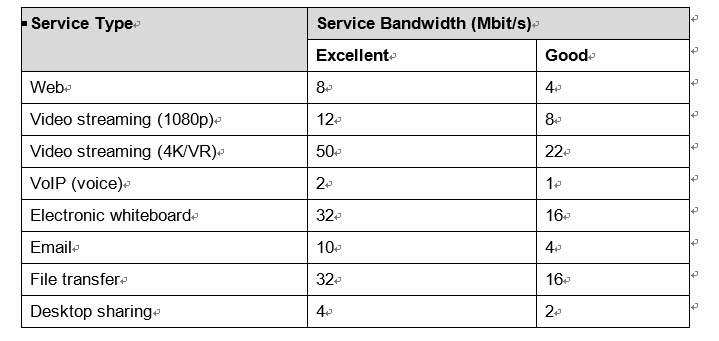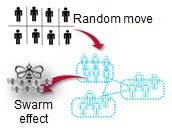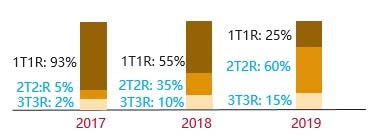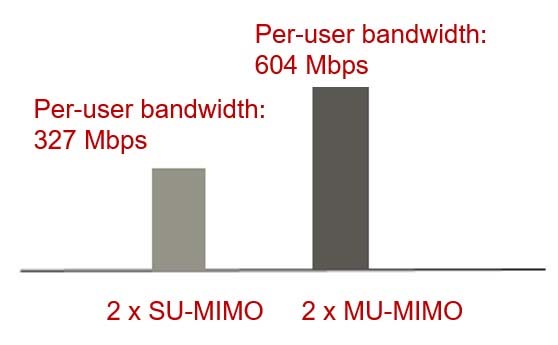As the number of Wi-Fi 6-capable Stations (STAs) continues to increase, wireless networks built using enterprise-class Wi-Fi 6 Access Points (APs) are becoming more popular than ever before.
When upgrading legacy or deploying new Wi-Fi networks, Wi-Fi 6 is the obvious choice for enterprises.
However, IT management personnel are often concerned about how to select the Wi-Fi 6 APs most suited to their service requirement from among the numerous types available. They are also concerned about how best to quickly deploy high-quality wireless networks.
Two factors determining WLAN throughput
There are two critical factors affecting the throughput, access capacity, concurrent capacity, and per capita bandwidth of an AP: radio spectrum resources (bandwidth); and the number of spatial streams of the AP (MU-MIMO capability).
An analogy commonly used to visualise frequency bandwidth is to do with the width of a road. Similarly, the number of spatial streams can be thought of as the number of overpasses. You can either expand the road or increase the number of overpasses to improve road throughput.

Throughput corresponding to the different number of spatial streams at HE80 MHz on the 5GHz radio
However, expanding the road will occupy additional valuable land resources, albeit at relatively low cost. In contrast, increasing the number of overpass levels cleverly reuses land resources, but the cost is far higher.
Radio spectrums on wireless networks are similar to valuable land resources, and are usually insufficient in continuous networking deployment scenarios. So adding spatial streams can help increase WLAN throughput.
A single radio of an enterprise-class Wi-Fi 6 AP supports up to eight spatial streams, delivering a throughput of up to 9,6Gbps.
4 x 4 MU-MIMO: A Must-Have for Building an Enterprise Wi-Fi 6 Network
More spatial streams means higher throughput and higher hardware costs. As such, enterprises need to choose APs based on their actual service requirements for the most cost-effective deployment.
Ever-changing service models drive enterprises to select APs with more spatial streams for Wi-Fi 6 network deployment

Service bandwidth requirements of different applications
In the past, services such as web browsing, email, cloud desktop and 1080p video streaming dominated network traffic in wireless networks, with a per-user bandwidth of only 4Mbps to 10Mbps on average.
However, with the emergence and popularisation of new technologies and services – such as streaming media advertisements, Virtual Reality (VR) and Augmented Reality (AR), 4K High Definition (HD) video, and intelligent office systems – the per-user bandwidth requirement has increased sharply, from 8Mbps to 50Mbps, or even 100Mbps.
According to Tolly’s test data, if services are initiated on 20 STAs concurrently, the total throughput of an enterprise-class 2 x 2 MU-MIMO Wi-Fi 6 AP at HE40 MHz is only 210Mbps, with an average per-user bandwidth of only 10Mbps – clearly failing to provide sufficient bandwidth.
To achieve a two-fold increase in the per-user bandwidth, with the same number of concurrent STAs and maintaining experience levels, enterprise-class Wi-Fi 6 APs working in 4 x 4 MU-MIMO mode or higher become must-haves.
Large-scale STA access drives enterprises to select APs with more spatial streams on Wi-Fi 6 networks

Two-fold increase in the number of concurrent STAs on each AP
Wireless networks will gradually outnumber wired networks. Of course, STAs can access wireless networks anytime and anywhere, and the number of STAs connected to each AP is going to increase significantly.
Before network construction, the advice to the majority of enterprises must be to plan a minimum of 30 to 40 concurrent STAs connected to each AP, if enterprise office and production requirements are to be met.
As previously stated, if services are initiated on just 20 STAs concurrently, the provided bandwidth of an enterprise-class 2 x 2 MU-MIMO Wi-Fi 6 AP only meets service requirements of 1080p video streaming. Therefore, Wi-Fi 6 APs working in 4 x 4 MU-MIMO mode or higher are essential.
Diversified STA types drive enterprises to select APs with more spatial streams on Wi-Fi 6 networks

2T2R MU-MIMO STAs gradually becoming the mainstream
The Wi-Fi network interface cards (NICs) of STAs on the move change from one spatial stream (1T1R: 1 x 1 MIMO) to two spatial streams (2T2R: 2 x 2 MU-MIMO).
On the move STAs launched after 2019 generally support two spatial streams. For example, the Wi-Fi NICs of Huawei, Samsung, Apple, and Xiaomi STAs are configured with two spatial streams as standard, and the Wi-Fi NICs of some PCs support three spatial streams. Therefore, each radio of an enterprise-class Wi-Fi 6 AP in 2 x 2 MU-MIMO mode can support concurrent access of two STAs with one spatial stream.
When STAs with two spatial streams are connected, each radio of an enterprise-class Wi-Fi 6 AP in 2 x 2 MU-MIMO mode can process services of only one STA at a time, which cannot bring the benefits of MU-MIMO into full play. As such, user bandwidth cannot be improved.

Per-user bandwidth provided by a 2 x 2 MU-MIMO AP and a 4 x 4 MU-MIMO AP with two concurrent STAs at HE80 MHz
As verified by Tolly, when two STAs with two spatial streams concurrently access a single 5GHz radio of an enterprise-class 2 x 2 MU-MIMO Wi-Fi 6 AP at HE80 MHz, the average throughput of each STA is just 327Mbps, due to air interface resource contention.
When an enterprise-class 4 x 4 MU-MIMO Wi-Fi 6 AP is deployed in the same scenario, it can schedule the two STAs at the same time. As such, the average throughput of each STA can reach up to 604Mbps.
Simply put, in scenarios dominated by STAs with two spatial streams, enterprise-class Wi-Fi 6 APs working in 4 x 4 MU-MIMO mode or higher are required to fully unleash the potential of MU-MIMO.
Conclusion
With all-wireless access already a cornerstone for enterprise digital transformation, the importance of Wi-Fi is self-explanatory. As the famous aphorism goes: “Hardware determines the lower limit, software determines the upper limit.”
Whether the benefits of a software scheduling algorithm can be fully realised is heavily dependent on hardware capability. Clearly, enterprises must consider both their service requirements and future service evolution, as well as upgrade costs, during network construction.
And the case for choosing enterprise-class Wi-Fi 6 APs in 4 x 4 MU-MIMO, when building a service-oriented, experience-centric Wi-Fi network, is an extremely strong one.
Click here for more information
